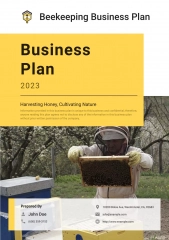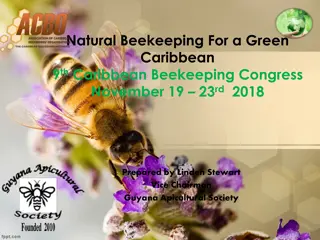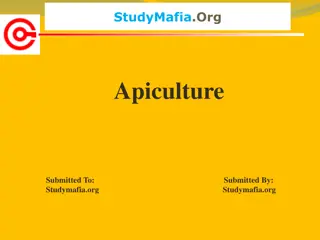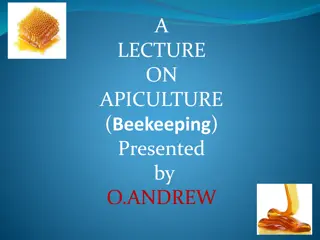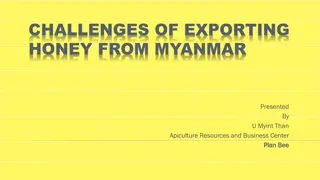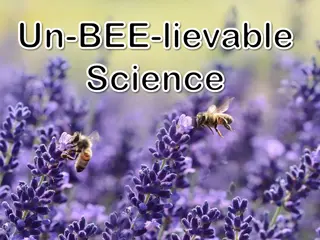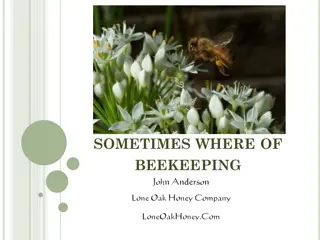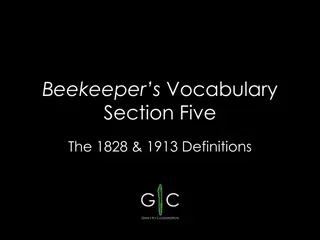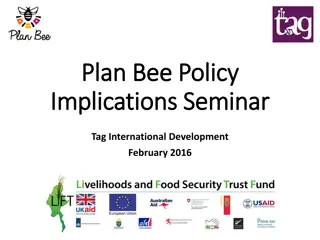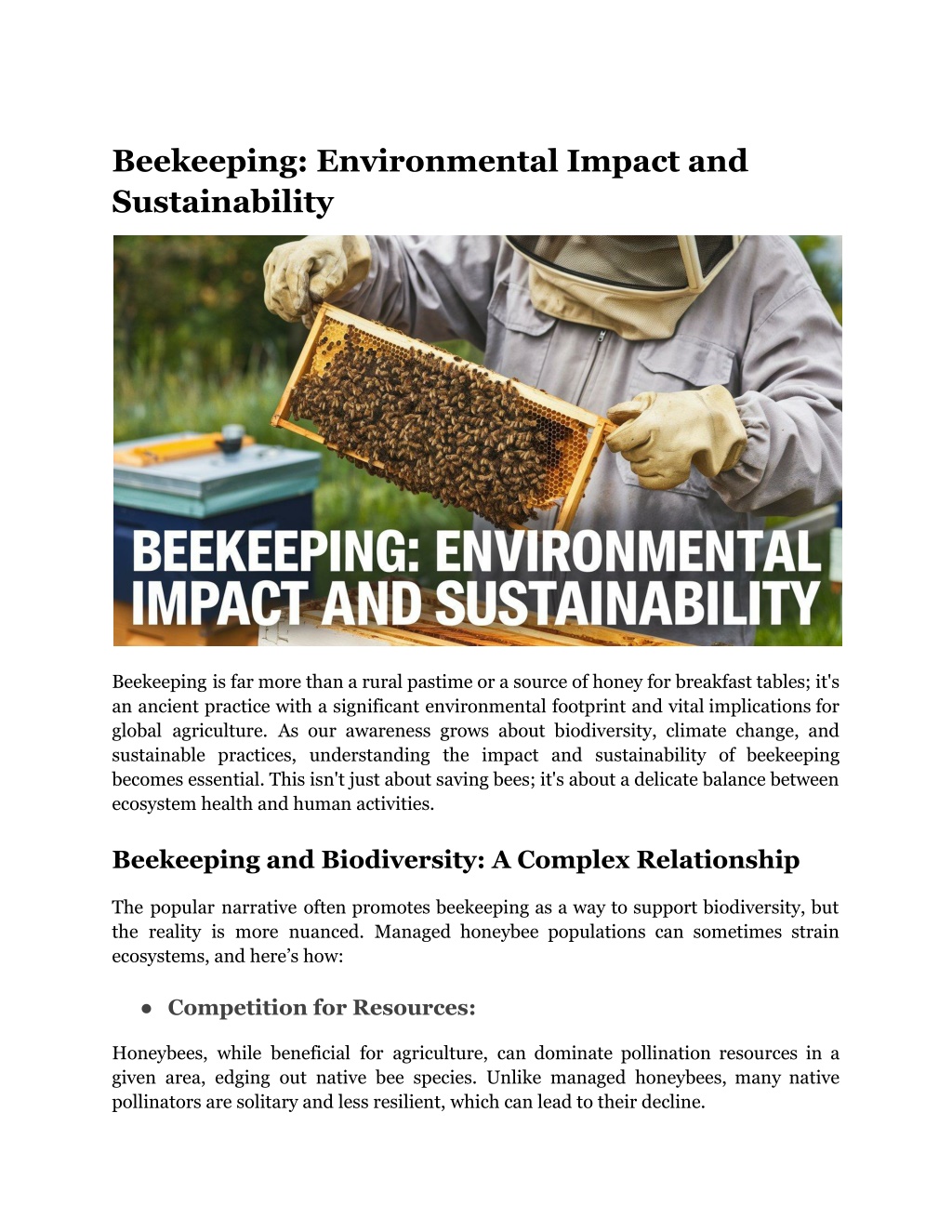
Beekeeping_ Environmental Impact and Sustainability
Discover how beekeeping supports biodiversity, boosts crop yields, and promotes sustainable practices for a healthier planet.
Download Presentation

Please find below an Image/Link to download the presentation.
The content on the website is provided AS IS for your information and personal use only. It may not be sold, licensed, or shared on other websites without obtaining consent from the author. Download presentation by click this link. If you encounter any issues during the download, it is possible that the publisher has removed the file from their server.
E N D
Presentation Transcript
Beekeeping: Environmental Impact and Sustainability Beekeeping is far more than a rural pastime or a source of honey for breakfast tables; it's an ancient practice with a significant environmental footprint and vital implications for global agriculture. As our awareness grows about biodiversity, climate change, and sustainable practices, understanding the impact and sustainability of beekeeping becomes essential. This isn't just about saving bees; it's about a delicate balance between ecosystem health and human activities. Beekeeping and Biodiversity: A Complex Relationship The popular narrative often promotes beekeeping as a way to support biodiversity, but the reality is more nuanced. Managed honeybee populations can sometimes strain ecosystems, and here s how: Competition for Resources: Honeybees, while beneficial for agriculture, can dominate pollination resources in a given area, edging out native bee species. Unlike managed honeybees, many native pollinators are solitary and less resilient, which can lead to their decline.
Pollination Imbalance: While honeybees are effective pollinators for many crops, they aren t suitable for all. Certain plants require unique pollination methods for native bees, such as buzz pollination. Over-reliance on honeybees can inadvertently lead to lower pollination rates for some native flora. Potential for Disease Spread: Managed bees are often transported across regions for crop pollination. This movement can introduce pathogens and parasites, like the deadly Varroa mite, to native pollinators that have no immunity against such threats. Aspect Potential Impact Notes Resource Competition Reduced resources for native pollinators Dominance threaten solitary pollinators of honeybees can Pollination Imbalance Unintended on plant diversity consequences Native flora depends on specific pollination methods Disease Spread Disease native bees transmission to Risk increases with commercial bee transportation Sustainable Beekeeping Practices To mitigate the environmental impact, beekeepers can adopt sustainable practices that prioritize the health of ecosystems as much as the production of honey. Here s what that looks like in action: Local and Seasonal Beekeeping: Rather than moving colonies across regions, localizing beekeeping helps minimize the spread of diseases and maintains the ecological balance in a specific area. Support of Native Pollinators: Planting a diversity of flowering plants and creating habitats for native bees can reduce the competitive pressure honeybees place on other pollinators. Reducing Chemical Use: Chemicals are sometimes used to control diseases within hives, but they can leach into the environment, harming other species. Natural methods, like using screened bottom boards to manage mites, can be equally effective without chemicals.
Climate Change and Beekeeping: The Vicious Cycle Climate change poses a significant challenge to both wild and managed bee populations, and the feedback loop between beekeeping and climate is undeniable. Temperature Sensitivity: Bees are highly sensitive to temperature changes. Warmer temperatures can lead to plants' early bloom, disrupting pollination's synchronization and reducing available nectar sources. Extreme Weather Events: Droughts, floods, and extreme weather events damage flowering plants, which bees rely on for food. When natural resources are scarce, beekeepers often have to supplement bee diets with sugar syrup, which lacks the nutritional diversity of real nectar. Carbon Footprint of Commercial Beekeeping: Transportation of hives across long distances contributes to greenhouse gas emissions. Local, stationary beekeeping is one of the simplest ways to cut down on these emissions. The Role of Honey in Sustainable Beekeeping Among unique honey varieties, Organic tupelo honey stands out not just for its taste but also for its environmental benefits when harvested responsibly. Tupelo trees, found primarily in the wetlands of Florida and Georgia, create a honey variety celebrated for its complex flavor and low glycemic index. Sustainable production of honey depends on specific practices that can support both bee populations and the local environment: Preservation of Wetlands: Tupelo trees thrive in wetlands, an environment critical for biodiversity. Sustainable beekeepers who produce Tupelo honey are actively invested in preserving these habitats, which are not only crucial for bees but also for other wildlife. Limited Harvesting Season: Tupelo blooms for a brief period each spring. This limited window reduces the stress on bees, allowing for a more natural and less invasive harvest cycle. Sustainable beekeepers avoid overharvesting and respect the natural flowering season.
Low Intervention Beekeeping: Tupelo honey is often harvested using minimal intervention techniques, reducing stress on bee populations. By avoiding chemical treatments and focusing on natural hive management, sustainable producers create purer honey while supporting bee health. Overproduction and the Ethical Dilemma in Beekeeping The rising demand for honey has led to intensive beekeeping practices. Large-scale operations focus on maximum honey production, often at the expense of bee health and ecological balance. Artificial Feeding: To maintain honey yield, some beekeepers remove honey stores from the hive and replace them with sugar syrup or corn syrup. This nutrient-poor diet can weaken bees immunity and disrupt their natural foraging instincts. Stress from Transportation: Bees transported long distances for pollination suffer from stress and increased disease susceptibility. Unlike natural, stationary hives, commercial hives face disorientation, disease spread, and even colony loss from the strain of travel. Solutions: How Beekeepers and Consumers Can Contribute to Sustainability While sustainable beekeeping practices are essential, informed consumer choices also play a pivotal role. Both beekeepers and consumers can contribute to an eco-friendlier approach: For Beekeepers: Adopt Integrated Pest Management (IPM): IPM uses natural methods to control pests without chemicals, helping maintain a balanced ecosystem. Encourage Floral Diversity: Planting a wide variety of flowers near hives ensures a steady and diverse nectar source, which is healthier for bees and reduces dependence on artificial feeding.
Use Local Bee Breeds: Indigenous bee species are better adapted to local climates and are more resistant to diseases, making them a more sustainable choice. For Consumers: Support Local, Sustainable Honey Producers: Choosing local honey reduces the carbon footprint associated with transportation and supports smaller, eco-conscious producers. Look for Certified Honey: Certifications like organic or sustainable honey can indicate that the product meets specific environmental standards. Be Mindful of Honey Varieties: Tupelo Tree Honey, for example, is not only a unique choice but, when sustainably sourced, supports the preservation of delicate wetland ecosystems. Final Thoughts The sustainability of beekeeping hinges on a balanced approach that respects natural processes and prioritizes bee health over maximum yield. While honey production is valuable, it's crucial to avoid treating bees as mere honey factories. Sustainable beekeeping is not just about honey; it's a commitment to preserving our environment and supporting biodiversity. Site Article: Beekeeping: Environmental Impact and Sustainability

